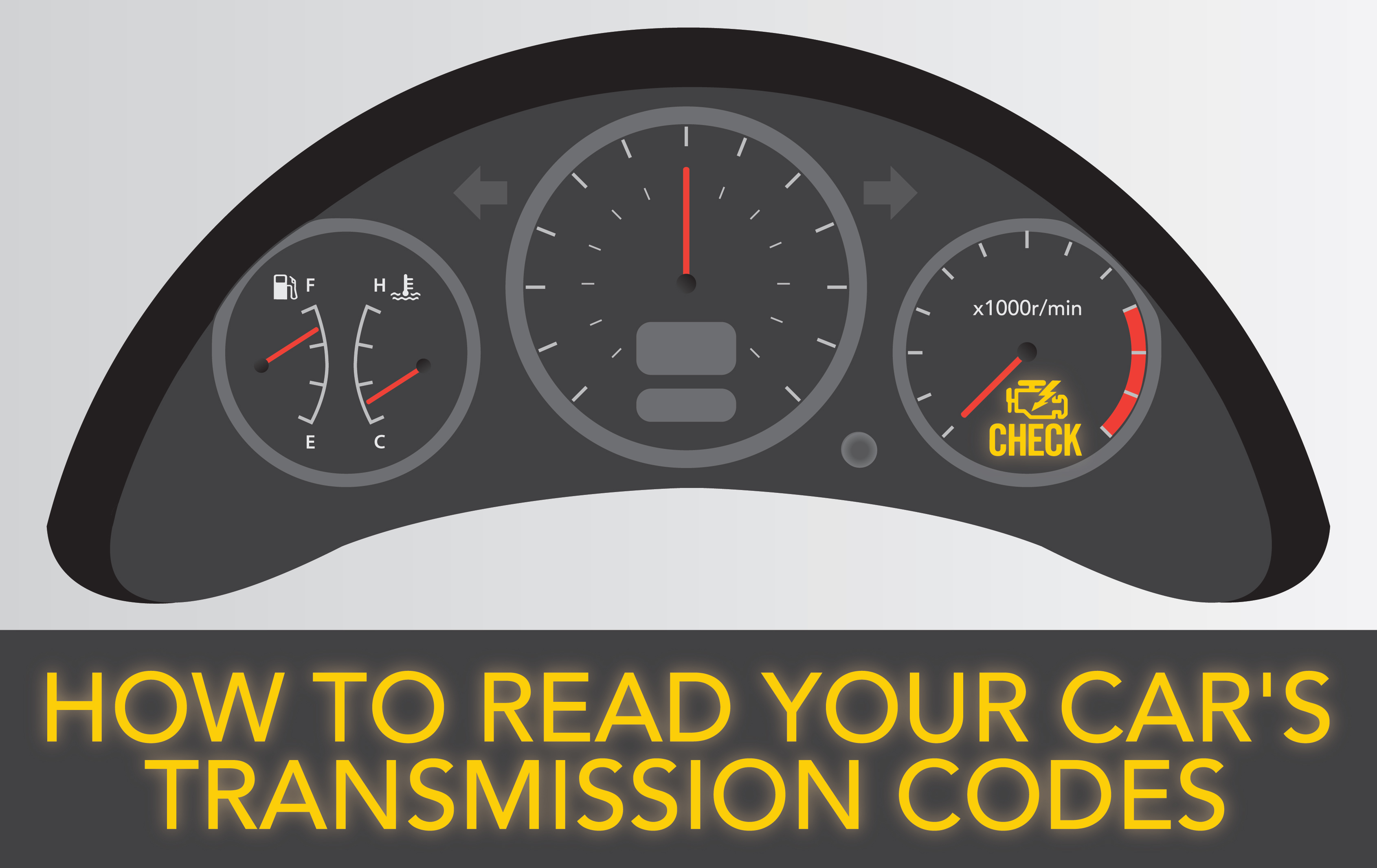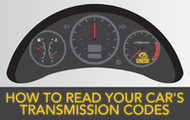How to Read Your Car’s Transmission Codes
10th Oct 2016

The transmission is a crucial component within any vehicle since it provides power to the wheels which in turn enables you to drive your car at a desired speed. But what if your transmission fails? If, for various reasons, you begin to suffer from a faulty transmission, you’ll likely need to check the vehicle’s transmission codes to determine the root cause of the problem.
But that’s just one part of the process. Knowing how to read these codes, even before you take your car to an auto technician, can significantly reduce any anxiety that comes with having a faulty transmission.
What does the “Check Engine” Light Mean?
For many drivers, seeing the “Check Engine” light on their dashboard suddenly flicker on can cause a lot of anxiety, especially if they’ve been experiencing performance issues when driving their vehicle. Though the lights may turn on due to many issues ranging from a loose gas cap to worn spark plugs, one issue that truly stands out relates to a faulty transmission.
If the “Check Engine” light is on and you discover that transmission codes are also present, your car likely does not need its spark plugs replaced. But first, you’ll need to know a lot more about the type of transmission code present on your car’s computer system before you can determine which aspect of the transmission is malfunctioning.
Distinguishing Between Global and Manufacturer Specific Transmission Codes
Once the Onboard Diagnostic System (OBD II) within your vehicle detects a problem related to the transmission, it will send at least one transmission code to the vehicle. This type of trouble code begins with P, for instance, PO218 and PO614. Usually a technician will connect a code reader to your dashboard to access the trouble code but anyone with the knowledge and skills to read these transmission codes can use the reader.
Both global and manufacturer specific codes begin with the letter P. However, the second character in the code will help you determine if it is global or manufacturer specific. For instance, in the case of a global transmission code, the second character is always a 0. These codes affect a wide range of vehicles regardless of their make or model. For instance, both P0218 and PO614 can be identified as belonging to the list of transmission codes for Hondas, Chevy, Ford and Toyota vehicles.
On the other hand, manufacturer specific codes, i.e. codes specific to certain vehicle models or manufacturers, use the number 1 as their second character. For instance, manufacturer specific transmission codes for Chevy include P1870.
Most Common Types of Global Trouble Codes
Whether you are a car enthusiast or just an average car owner, being able to read transmission codes will improve your confidence on the road. Below is a list of several global trouble codes every car owner should know about! Click on any of the codes to be taken to more information below:
|
P0218 |
|
|
P0613 |
|
|
|
|
|
|
|
|
|
|
|
|
|
|
P0218
This code is one of the most common and is normally associated with an overheating transmission. When this code appears together with other trouble codes, it usually indicates that the problems affecting your vehicle are complex. In such cases, you will need the assistance of a transmission code specialist to verify the possible causes and solutions for these transmission problems. If, the code stands by itself however, the causes may be limited to issues related to your transmission fluid. For instance, check if the fluid in the transmission is too low. If this is not the case, it may mean that your fluid sensor is malfunctioning and in need of a replacement.
Whatever the problem may be, P0218 requires careful deliberation before any conclusion regarding the cause of overheating is made. Weigh your options and determine if you need help from a specialist before making any permanent changes to your transmission. Also refrain from any long-distance driving to prevent further damage to your vehicle.
P0613
Whether you are looking at a list of transmission codes for Toyota, Chevy or Honda vehicles, you will likely come across this code. P0613 affects vehicles with automatic transmission. If you fall in the automatic transmission vehicle category, note that PO613 indicates there is a problem with your Transmission Control Module (TCM). Sensors within automatic transmission vehicles send electrical signals to the TCM. The TCM then interprets these signals in order to control or shift gears automatically. Once there is a problem with the TCM, such as a poor electrical connection or programming issue, your vehicle’s gear shifting mechanism will not work efficiently.
Since this is related to the TCM and often results from an internal problem with the TCM, it is advisable that car owners with this issue contact the manufacturer of the vehicle. They will be equipped with appropriate parts, tools or software needed to fix the issue in most instances.
P0614
Like transmission code P0613, P0614 only affects automatic transmission vehicles. The code occurs when there is a problem that prevents the Engine Control Unit (ECU) and TCM from communicating with each other. When this occurs, car owners may notice certain symptoms affecting their vehicle including the stalling of the engine, difficulty shifting or sluggish acceleration.
The problems associated with P0614 may be corrected after proper diagnosis of P0614 takes place. This may be done through the meticulous inspection of wiring and components related to your car’s Power-train Control Module (PCM), the section of the vehicle which usually includes both the ECU and TCM. If the problem causing P0614 originated from a fault within the PCM, it may need to be replaced as soon as possible. After all, driving a car with this type of transmission issue may result in you becoming stranded on the road.
P0700
P0700 is another transmission code related to a problem with your vehicle’s transmission control system. This code is usually accompanied by symptoms that include engine stalling, poor gas mileage and difficulty with transmission shifting.
Since this code is often accompanied by other transmission codes, it’s important that car owners know how to read each code. Regardless of whether or not you have a skilled transmission code specialist or automotive technician, knowledge of P codes like P0700 will better enable you to provide informed answers to questions the technician may ask. You will also be more able to identify symptoms your car has been experiencing that are associated with the codes present on your vehicle.
P0706
P0706 normally indicates that there is a problem preventing your Transmission Range Sensor, TCM or PCM from functioning correctly. When this occurs, your vehicle’s TCM and PCM which usually receive information from the transmission regarding the gear your vehicle is in, will not receive the information required. This will result in a decrease in fuel economy, inability to shift properly or go into gear, or in some cases, there may be no discernable symptoms.
If a defective Transmission Range Sensor is the problem, it may need to be replaced. If the problem is due to damaged, corroded or shorted electrical connectors or wiring, these can be replaced with new ones. You may also need to check the quality of the transmission fluid as the presence of dirty fluid could result in P0706.
P0715
P0715, also known as an Input/ Turbine Speed Sensor Circuit Malfunction, affect various vehicles. Transmission codes for Chevy and other popular car brands include P0715. It occurs when errors prevent the transmission control system from properly reading your engine’s RPMs. Whenever this issue is present, the Onboard Diagnostic System (OBD II) sends the code to the vehicle, resulting in the “Check Engine” lights flashing on your dashboard as an indication that something is likely wrong with your transmission. You will also notice that your vehicle fails to shift gears properly.
P0720
This occurs when the output speed sensor circuit malfunctions. The output speed sensor is that section of the transmission – in most models it is located at the end of the transmission – that determines shift scheduling. It also may result when the information relayed by the output RPM sensor and the input RPM sensor does not coincide.
If any of these failures occur, or if defective wiring or connectors are present, you will need a proper diagnostic before the problem can be fixed. Depending on the problems that trigger the issues related to P0720, your auto technician may replace the output speed sensor, engine coolant temperature sensor, or output speed sensor wiring. Once any of these issues causing P0720 are fixed, you will no longer see the “Check Engine” light blinking on your dashboard. Of course, that is assuming there were no other transmission trouble codes affecting your vehicle. Also your vehicle should shift properly and your fuel economy increase. Your speedometer may read erratically or not at all.
P0729 - P0736
Like the other codes mentioned on this list, transmission codes between P0729 and P0736 affect automatic transmission vehicles. When P0729 - P0736 trouble codes occur, the vehicle will be unable to shift into the desired gear and the “Engine Light” will be on. The codes can be identified easily since each code normally correlates with a specific gear. For instance, P0729 manifests itself when the vehicle is in 6 th gear.
Effective diagnostic and repair procedures usually involve checking the transmission for signs of reduced fluid level or contaminated fluid. The auto technician may also check for faulty shift solenoid or faulty hydraulic circuit.
P0750
When the shift solenoid malfunctions, the transmission code that usually follows is P0750. The vehicle affected will not function correctly. Moreover, the solenoid valves which enable fluid to pass through the transmission will not open and close in the way they should. This will lead to improper hydraulic fluid levels within your vehicle which in turn prevents you from shifting to low gears. P0750 is only one of the many transmission codes related to a malfunctioning solenoid. Honda transmission codes and trouble codes of other car brands related to solenoid failure range between P0750 and P0770.

